It is one of the biggest tourist draws in Highland Perthshire, but when it was first built locals feared the Pitlochry dam would kill off the industry in the area.
More than 70 years on, 500,000 people visit the site every year.
Now members of the public will be able to get an insight into the history of the dam, which was completed in 1951, with the opening of a new public archive.
Much of the material found in the files has never been seen in public before.
The archive will be officially opened by Finance Secretary and local MSP John Swinney on Friday, with appointments to view the documents available from next Monday.
Among the manuscripts held in the archive, which is in the shadow of the dam, are protest leaflets and letters dating from the 1940s.
Alasdair Bachell, heritage archivist at SSE, said: “There are interesting stories about how the dam started the North of Scotland Hydro-electric Board was set up in 1943 by an Act of Parliament and it was quite controversial at the time.Click here to view more archive photos“The schemes that were proposed were on some of Scotland’s major fishing areas. There was quite a lot of worry about the impact on the environment and tourism.
“We have a leaflet from one of the local protest groups outlining all the cons of having the scheme built, and as an alternative they were talking about the new atomic energy and how it would bring about free electricity for all which in hindsight we know is not the case.”
The story of a record-breaking tunnel-building exercise also features in the files.
On October 20 1955 a group of men, known as the Lednock ‘tunnel tigers’, spent a week grounding their way through 557 feet of rock at St Fillans using only pickaxes and dynamite.
The man who designed the Pitlochry power station, Sir Edward MacColl, did not live to see his creation open.
Alasdair said: “He was widely regarded as the pioneer of hydro-electricity in Scotland.
“He quite suddenly died in 1951, just before the opening of the Pitlochry and Clunie power stations.”
